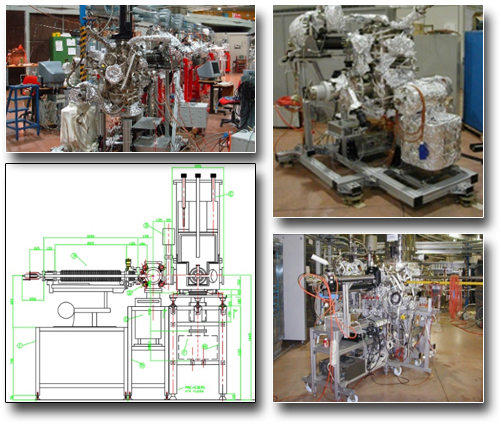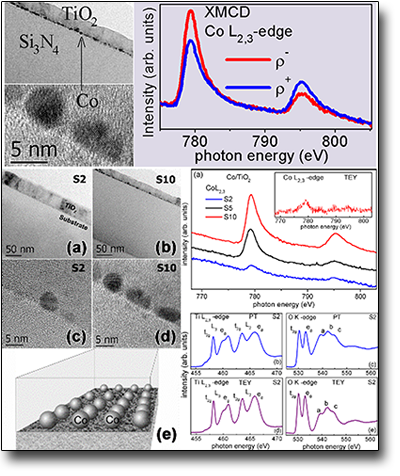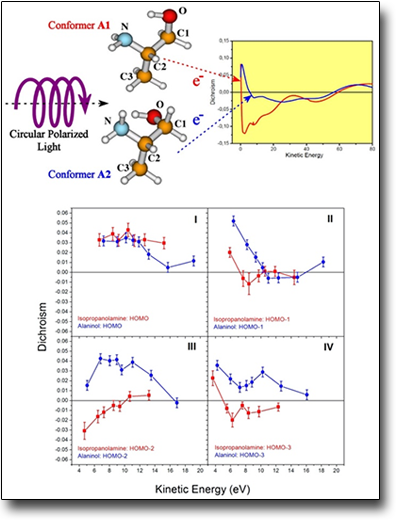
CIrcular POlarization Beamline (CIPO@Elettra)
Nicola Zema -
“Circular Polarization” (CIPO) Beamline - Elettra, Trieste
The Circular Polarization beamline (CiPo) is characterized by its capability of providing a Synchrotron Radiation Beam of variable polarization (Circular to Linear) in a very broad range of photon energies, 5 to 900 eV. The photon beam is produced by an Electromagnetic Elliptical Wiggler and is dispersed by means of two collinear monochromators, a Normal Incidence Monochromator (NIM) and a Spherical Grating Monochromator (SGM), that alternatively provide two beams in the UV-VUV (5 - 40 eV) and soft X-rays (40 - 900 eV) respectively. The availability of such a wide photon energy spectrum, together with the polarization selection makes the CiPo beamline extremely flexible for the experimental activity. The CiPO Beamline itself can be considered a research instruments that can be coupled with other experimental instrumentation that ,taking advantage from photons with variable and well defined energy and polarization available for sample excitation, analyze the following response improving their capability. Photoemission techniques such as XPS,UPS, PECD, TEY developed a lot with respect to the laboratory equippments as well as Photoionization Mass Spectrometry and Core level Absorption Spectroscopy (XAS, NEXAFX, XMCD, XNCD, etc.)
Several equipments are available for performing different type of experiments:
- Core Level Absorption spectroscopy from solid surfaces, thin films and molecules (XAS) and, taking advantage of circular polarization, measurement of the X-Ray Magnetic Circular Dichroism (XMCD) of magnetic films and low-dimensional systems result as the primary scientific research field. Absorption techniques are performed at variable temperature and Magnetic field.
- XPS/UPS Photoemission UHV chamber for investigation of clean and dosed sample surfaces “in situ” prepared and characterized.
The CiPo Beamline gives also the possibility to perform gas phase experiments on atomic and molecular systems, in particular Photoelectron Circular Dichroism (PECD) on chiral molecules.
- Mass Analysis Photoionization and photofragmentation setup for studying mass spectra, photoionization efficiency curves and kinetics of ion-molecule reactions of molecules in gas phase.
TECHNICAL SPECIFICATIONS
XAS/XMCD End-Station - Photon Beam Characteristics
- Spectral range: 40-900 eV
- Resolving power: 10000-3000 depending on photon energy
- Spot size on sample: 0.3x0.1 mm2
- Polarization Degree: 95-70% depending on experimental conditions
- Sample Temperature: RT-4K
- The XAS/XMCD End-Station allows for absorption experiments under two different range of magnetic field, with the following specifications:
- Low Magnetic Field: up to 0.4 T by means of an electro-magnet
- High Magnetic Field: up to 4.0 T by means of a super-conducting magnet
- Helium cooled 5-degrees manipulator: down to 4°K from room temperature
The XMCD End-Station is also equipped with a preparation chamber for in-situ sample treatment and preparation
UPS and XPS End-StationThe UPS and XPS End-Station is a quite standard photoemission set-up for surface photoelectron spectroscopy. The apparatus consists of an UHV measurement chamber equipped with a VG sample manipulator with variable temperature (300K-100K) and Electron Energy Analyzer OMICRON 125HR that allows both valence band and core level photoemission spectra and presents the following specifications:/p>
- Omicron 125HR: emispherical electron kinetic energy analyzer with 5 channeltrons
- Angular acceptance: 2°-16° depending on lens mode setup
- Electron Kinetic energy resolution: 1.5-0.003 eV pass energy dependent
- UHV < 5x10-10 mbar
- Helium cooled 5-degrees manipulator: down to 100°K from room temperature
- Excitation Photon Energy: 10-800 eV
The UPS and XPS End-Station is also equipped with a preparation chamber for in-situ sample preparation and treatment.
PECD End-Station
The PECD End-Station allows for photoelectron circular dichroism experiments on chiral systems in the gas phase, and presents the following specifications:- PECD experiments are performed on a standard photoemission set-up. On the beamline are available on request a set-up based on a Velocity Map Imaging and a hemispherical electron analyzer. The typical resolution of the experiment is about 300 meV in the photon energy range 15-30 eV.
- Liquid sample. The sample is placed in a glass tube and connected to the ionization chamber through a needle. The gas line of the sample can be heated up to 150 °C.
- Powder samples. The sample is evaporated by heating a furnace. The furnace can be heated up to 150 °C.
- Differential pumping separation between experimental and beamline vacuum.
AVAILABLE TECHNIQUES
XAS/XMCD in UHV e soft X-ray
- Core level Absorption Spectroscopy for investigating electronic empty states and their role in the formation of bonding in the modification of materials
- XMCD on Magnetic films and low dimentionality systems
- XMCD in Transition Metal Compounds -Transition Metal nanoparticles; Magnetic Behavior at Low Dimensionality
- Soft X-Ray Magnetic Scattering
Photoemission UPS/XPS
- Resonant Photoelectron Spectroscopy of Transition Metal Compounds
- Chemical Analysis of material compounds via binding energy detection of core levels photoelectron kinetic energies (ESCA)
- Determination of the electron density of states in the valence band by measuring the distribution of the valence band emitted photoelectron.
- Self Assembled Monolayers on surface metals valence and core level states analysis
- Metal-localized Interface States Probed by Energy Dependent Photoemission
- Properties of Self-assembled Chiral Molecules on Metal Surfaces
PECD
Photoelectron circular dichroism (PECD) is a novel type of spectroscopy for investigating chiral molecules in gas phase exploiting circularly polarized light in the VUV and Soft X-ray range. Circular dichroism stems from the difference D between spectral photoemission intensities taken with right I(RCP) and left circular polarized light I(LCP). PECD is related with the interference of the l ± 1 outgoing partial wave. This term is not null in the case of chiral molecules measured in angular resolved mode and provides the full information of phase difference between outgoing partial waves. The oscillatory behavior of the PECD signal allows us to have a superior sensitivity to electronic and structural properties of molecules through D parameter dynamics that presents surprising sensitivity to the conformational effects in chiral systems. In fact, while non polarized photoelectron spectroscopy mainly responds to conformational effects in terms of energy level shifts, PECD coupled with circularly polarized synchrotron radiation, provides a rich and detailed response to tiny changes in electronic and structural properties by means of the behavior of intensity dispersion of the circular dichroism D as a function of photoelectron kinetic energy.
- PECD for valence band and core levels
- Photo Electron – Photo Ion COincidence (PEPICO) circular dichroism
SAMPLE
-
Ordered Metal Surface clean and functionalized
-
Thin films and interfaces with particular attention to systems containing Transition Metal elements
-
Chiral Molecules in gas phase and deposited on TM surfaces, Chemistry of conformers, Photo Ionization dynamics
USE FOR
-
Electronic and magnetic properties of thin films and nanostructures grown on ordered surface for magnetic storage and sensors
-
Investigation of the Electronic properties of Chiral molecules for the functionalization of surfaces to be used as selective catalysts for the chiral enantiomeric reactivity with other chiral molecular compounds
Case Studies
Bulk sensitive x-ray absorption and XMCD: Co nanoclusters in TiO2 matrix
Ferromagnetic metal nanocrystals in semiconducting hosts are currently investigated for their potential applications in nanotechnology. Still, the controlled growth of the nanocrystals along particular directions or planes is not yet achievable in most nanocomposites like Co/TiO2, where preferential localizations are generally accompanied by a distribution of nanoclusters over the whole overlayer. Here we present planar arrays of cobalt nanoparticles embedded in TiO2 layers prepared by pulsed laser deposition on amorphous Si3N4 membranes. High resolution transmission electron microscopy reveals the presence of Co nanocrystals arranged in bidimensional arrays at the film−substrate interface within the rutile TiO2 matrix. X-ray absorption spectra at the Ti L, O K, and Co L-edges carried out in surface sensitive and bulk sensitive modalities confirm the rutile phase of the titania matrix and the metallic state of Co atoms and indicate only negligible concentration of Co in the near- surface layers. Based on these results, a route for the synthesis of bidimensional arrays of Co nanoparticles within the rutile TiO2 matrix is proposed.


PECD spectra of molecular orbitals of structural isomers show similarities and differences
Conformational effects in photoelectron circular dichroism
In this review work the scientific activity of the CiPo research group is summarized, together with the state of the art literature of PECD. The sensitivity of PECD to conformational effects is the distinctive character of PECD with respect to classical photoemission spectroscopies. The scientific activity enlightened the key role of DFT theory to effectively model the experimental spectra in conformational studies. PECD of molecules sharing similar electronic and structural properties revealed in the interpretation interesting aspects of the interplay between structural and electronic properties. Moreover from the experimental analysis it was demonstrated the possibility of disentangle spectral contributions of a single conformer in a population at thermal equilibrium, opening new perspectives in the molecular conformer study.
Journal of Physics Condensed Matter, 29 (2017) 503001 DOI: 10.1088/1361-648X/aa9730

 English (UK)
English (UK)  Italiano (Italia)
Italiano (Italia)